Team-BHP
(
https://www.team-bhp.com/forum/)
- -
Driven: Lexus ES 300h
(
https://www.team-bhp.com/forum/test-drives-initial-ownership-reports/205507-driven-lexus-es-300h.html)
The
Lexus ES 300h is on sale in India at a price of Rs. 59.13 lakhs (ex-Delhi).
What you'll like:
• Funky styling stands out from the crowd. Decently priced for a CBU too (
imported as is from Japan)
• Hybrid powertrain with good low-end torque and a butter-smooth CVT gearbox
• Very good for city usage due to mileage and comfort offered
• Loaded with kit (heated and ventilated front seats, 17-speaker sound system, heated and reclinable rear seats)
• Lexus' track record of reliability & exemplary customer service
What you won't:
• Weird front styling not to everyone's taste
• Not as much fun to drive as its German competitors
• CVT can get lazy & noisy with a heavy right foot
• Unintuitive infotainment system with a touchpad that is poorly positioned for a right-hand drive vehicle
• Tiny sales network. Period
This review has been jointly compiled with Ajmat & ChiragM. Thanks to them for the expert observations & photography! 
Exterior
Lexus would have been selling cars in India from as early as 2013 had it not been for the increased import duties causing them to delay their plans. But as the saying goes, "better late than never". They finally began their Indian operations in early 2017 with the launch of 3 models - The ES 300h, RX 450h and the LX 450d (all overpriced). In spite of the higher price tag, they haven't looked back and have continued launching new cars to catch up with the competition. 2018 saw the launch of the flagship LS sedan and deliveries of the NX 300h began. Swanky showrooms have also opened up in most metros and they continue to attract buyers with their luxury customer experience. However, this still doesn't hide their hefty commanding price tag due to CBU pricing.
The ES 300h was one of the first offerings from Lexus in India, but it was already at the end of its life cycle as the 7th gen was set for launch a year later. Lexus unveiled the 7th gen ES at the Beijing International Automotive Exhibition in April 2018. Bookings for the new car opened in India in July and it was on the roads a couple of months later. In fact, India got the new ES even before the UK. Being a CBU, it's much easier for the Japanese car maker to bring their products to India as it doesn't have to go to through the rigorous homologation process for locally manufactured vehicles.
To distinguish the ES from the European pack, Lexus will continue to offer the ES with a sole hybrid powertrain. Being the luxury brand of Toyota, Lexus offers the buyer the best of both worlds - Japanese reliability combined with luxury. Other countries get the ES 200 and the ES 250 four-cylinder petrol variants and a 3.5L petrol V6 in the ES 350, while India gets only the ES 300h Hybrid. The same powertrain is seen in the Toyota Avalon as well as the Toyota Camry Hybrid. Hybrids make perfect sense for India as they're built for exactly our driving conditions. The transition to all-electric will happen, but with the current infrastructure, hybrids offer the best of both worlds. With the upcoming emission regulations (BS6 emission norms), hybrids are what can fill the gap till the EV revolution starts in India.
Underpinning the ES 300h is the Toyota New Global Architecture (TNGA: GA-K). The platform also underpins the new Toyota Avalon and the new Toyota Camry. Lexus has their work cut out as the new Camry will also be offered in hybrid only powertrain (most likely).
Just like other Lexus models, the ES comes with the huge spindle grille, which remains a love it or hate it design. The grill is bolder than the older gen ES with sharper lines as well as vertical slats following the spindle design vs the plain horizontal grill. There is no denying the fact that this car has street presence and personality in person. It definitely stands out from the Audi, BMW and Mercedes on the street. There's also lots of chrome all over to add more bling to the design:

The sharp design language continues at the rear, which is way more aggressive than the outgoing design. It's also much more pleasing to view from this angle due to the lower stance. The car measures 1,865 mm in width and 1,445 mm in height:

At 4,975 mm long, the ES is huge. In comparison, the 5-series measures 4,936 mm in length. However, at 2,870 mm, the wheelbase is shorter than that of the BMW, which stands at 2,975 mm. The E-Class is in another league as it is a long wheelbase model. The windows get a chrome surround. Overall silhouette is much sharper than the outgoing model. Moderator
ajmat feels that the car looks better in motion than standing still:

ES stands for 'Executive Sedan'. The fit and finish are perfect and there are no ugly panel gaps. Paint quality is also exemplary and the blue stands out in a crowd of white, silver and black cars. Darker colours highlight the chrome while lighter colours like silver hide the bling from the chrome. Lexus offers 9 exterior colour options:
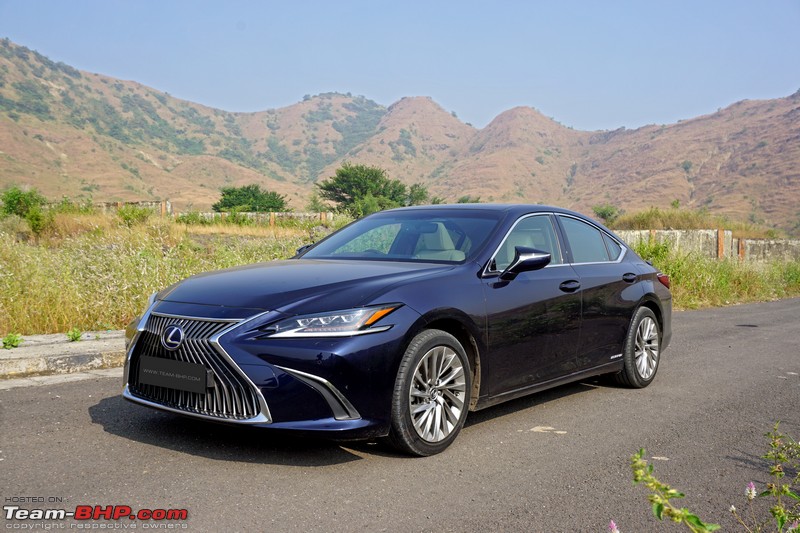
Like all Lexus cars sold in India, the ES is a CBU. This pushes the on-road price as some states have a higher tax for CBUs:
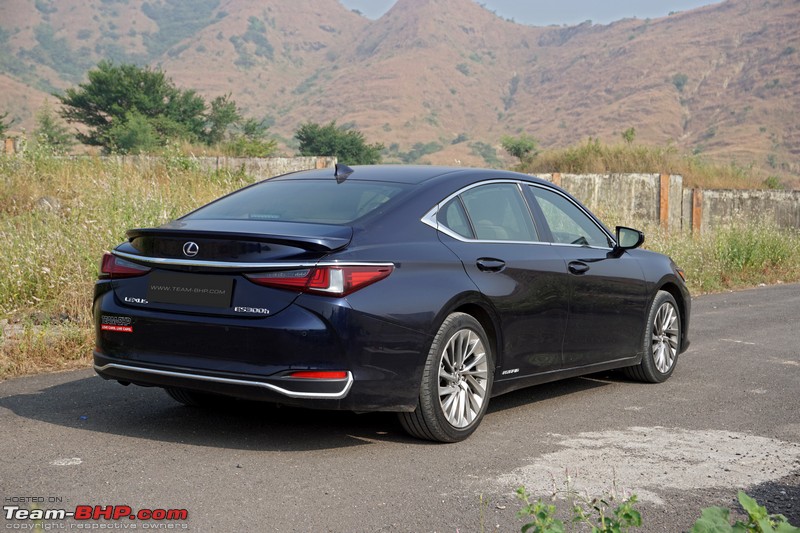
Tri-beam LED headlights with the indicator and DRL below. While the sedan comes with automatic lights, auto high beam has been removed from the Indian car. Note the neatly integrated headlamp washer below the headlights:
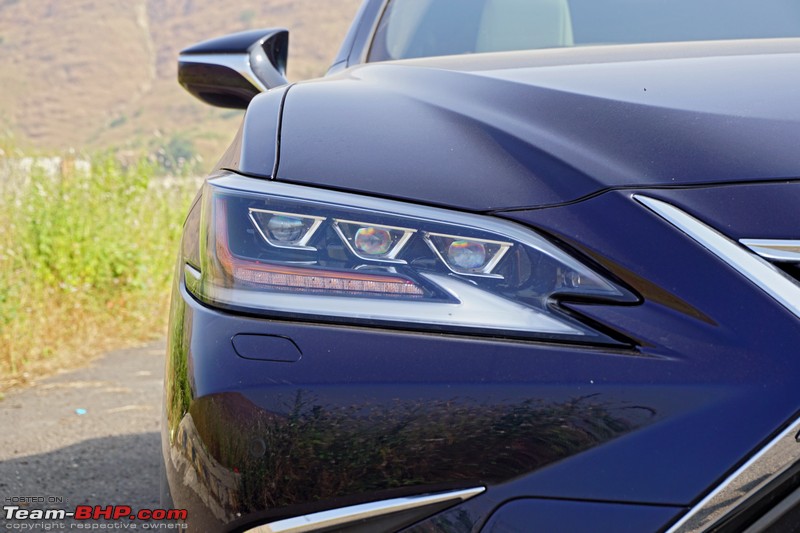
The wraparound headlights get 'LEXUS' lettering at the top:

The L-shaped LED DRLs are bright and adds to the road presence. The front is dominated by the spindle grill, but also notice the 3 sharp creases culminating at the middle of the grill. The front windshield is fitted with acoustic glass with sound insulating properties:
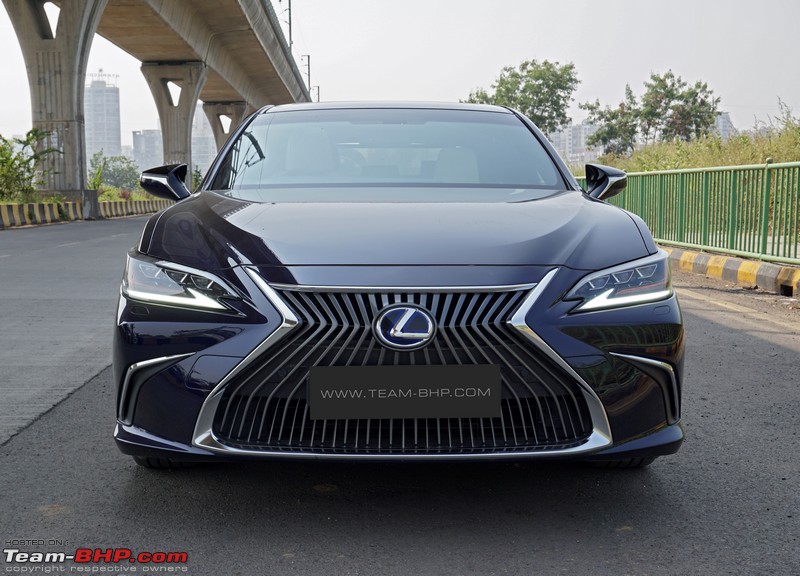
With all the lights in action. The car comes with LED cornering lights. The LED headlights are fantastic and do a phenomenal job of lighting the road ahead at night:

The front end is dominated by this huge spindle grille with vertical slats. The chrome bordering the grille extends upwards almost till the bonnet. Since this is a hybrid variant, the Lexus logo gets blue bordering:

The spindle grille with the chrome border extends till the front lip. The ES gets 4 front parking sensors. The boomerang-shaped side vents are fake with a chrome border on top. No fog lights as well:

Decent amount of underbody protection. With a ground clearance of 150 mm, you need to be careful when going over large speed breakers:

Smart looking ORVMs come with integrated turn indicators and a chrome accent. They are electrically adjustable and foldable and retract when the car is locked. Notice the new trend where the ORVM is mounted on the door rather than the corner of the window:

All four doors get a sensor placed at the top of the door handle. Just walk up to the car with the key in your pocket and it automatically unlocks:

18" multi spoke alloy wheels shod with 235/45 Bridgestone Turanza rubber. The T005A Turanzas are Bridgestone's flagship comfort tyres with lowest road noise. The spokes are hollowed out to further reduce road noise:

The sloping roof gives the car a coupe-like stance. The roof gets a shark-fin antenna:

Both the rear doors get a 'HYBRID' badge. This is the only hybrid in this segment:

A simple electric sunroof. No panoramic roof available is an unpleasant surprise at this price point:
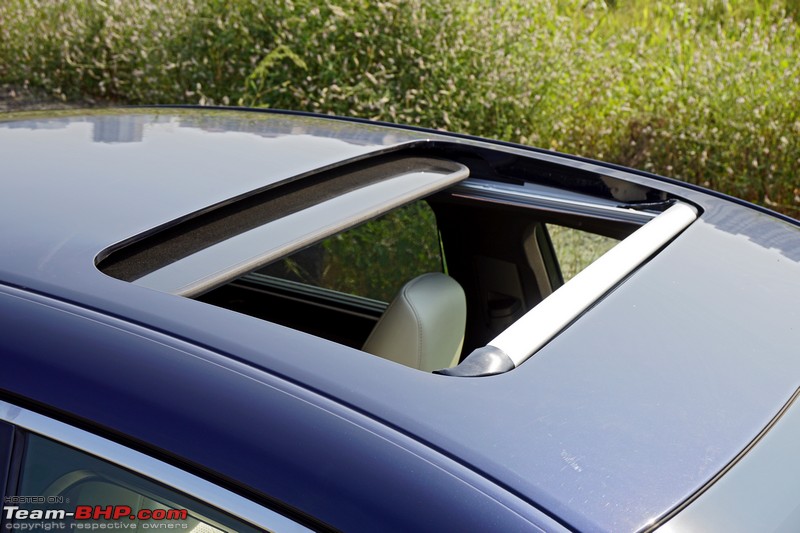
The rear features a chrome bar running across the width of the car. There's also a lip spoiler which gives the rear a sporty coupe-like stance. Just like the Lexus logo at the front, the logo at the rear also has a blue border. The '300h' logo also has blue colouring on the inside. The reverse camera is centrally located above the number plate:

The wraparound tail lights are full LED units. Notice the chrome strip that extends over the body on top of the tail lamps:
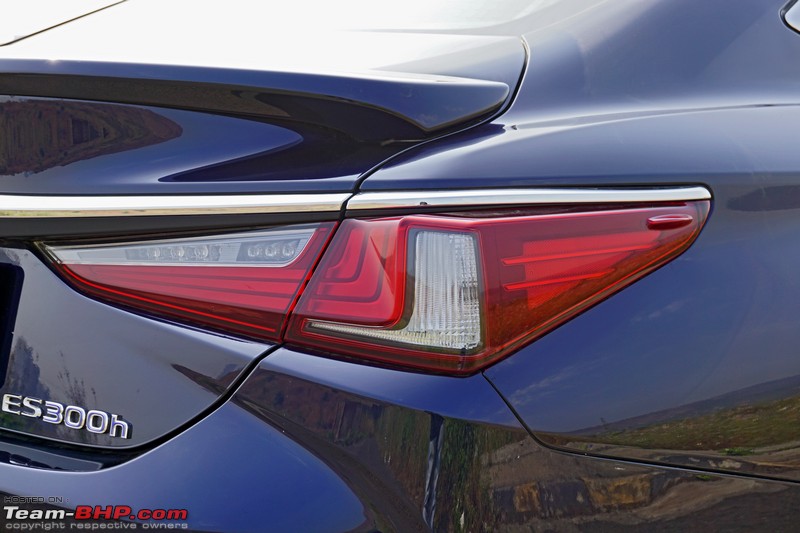
With the quintessential Lexus L-shaped tail lights in action:

There's another chrome bar that runs across the width of the car on the bottom of the rear bumper. The car gets four rear parking sensors. No fake exhausts or enlarged exhaust tips here. The exhaust is just one small round tip on the left:

A view of the underbody from the rear:

Interior
Step inside the ES and you are greeted by a typical Lexus dashboard. There are switches and buttons all over the dash, steering and center console. There are even 2 round knobs on either side of the instrument console that is inspired by the LFA. It's the opposite of Volvo, who believe in a minimalist design. The steering wheel is similar to the one found in the LS. The interior features mass-produced handcrafted items. Lexus offers a variety of customization options. Customers can choose from 4 colours for the leather upholstery and 3 wooden trims:

The dashboard features a mix of leather, wood, and faux metal. The stitching is accurate and the leather facings get 3D printed lines to reduce stickiness. Disappointingly, the bottom half of the dash, centre console and door sills are finished in hard plastics:

The 3-spoke multifunction steering wheel is leather-wrapped with wooden trims. The steering mounted controls get a silver border. The steering wheel is nice to grip with thumb contours at the 10-2 position, which makes it more suitable for wafting, as opposed to carving corners:

The buttons on the right side of the wheel are used for cruise control, while the ones on the left can be used to operate the MID and voice commands. They can also be used to choose various audio modes and to tune FM stations. The Indian car has lost some features and that has resulted in a couple of blank buttons on the steering wheel, shockingly at this price:
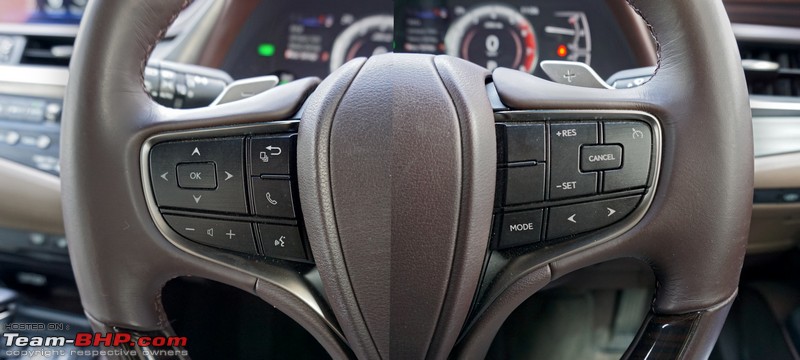
Paddle shifters on both sides of the steering wheel - one on the left to shift down and the one on the right to shift up. Paddles have a good response time and offer good engine braking:

The instrument cluster display can be toggled between analog and digital and it also changes depending on the drive mode:

The MID shows a variety of information including efficiency, range, energy monitor and tyre pressure for all 5 wheels. It can also display, navigation, audio, cruise control settings and vehicle alerts, including open doors and rear passenger seatbelt warning. When the car starts moving, the rear passenger seatbelt warning starts beeping, which then becomes continuous:

You also get a Head-Up Display (HUD) which projects the energy monitor as well as a tachometer. The blue bar in the navigation system blinks when you are nearing a turn:

The left stalk is for the lights and indicators while the right stalk is for the wipers. This will take some getting used to in a Japanese car. Being a CBU import and targeted mainly for the left-hand drive US market, the stalks remain LHD oriented:

Unusual placement for the traction control button and the button for the various driving modes. These cylindrical knobs are placed on either side of the instrument cluster. Even the LS sedan gets similar stalks inspired by the LFA sports car:

To the right side of the steering wheel, there is a small storage space along with buttons for the HUD, fuel cap release and the boot release. The plain buttons on top indicate missing features. This is something you do not expect from a car at this price range:

Buttons to brighten the HUD, as well as the instrument cluster, are placed behind the steering next to the instrument cluster:

A simple power on/off button finished in blue to denote the hybrid power unit:
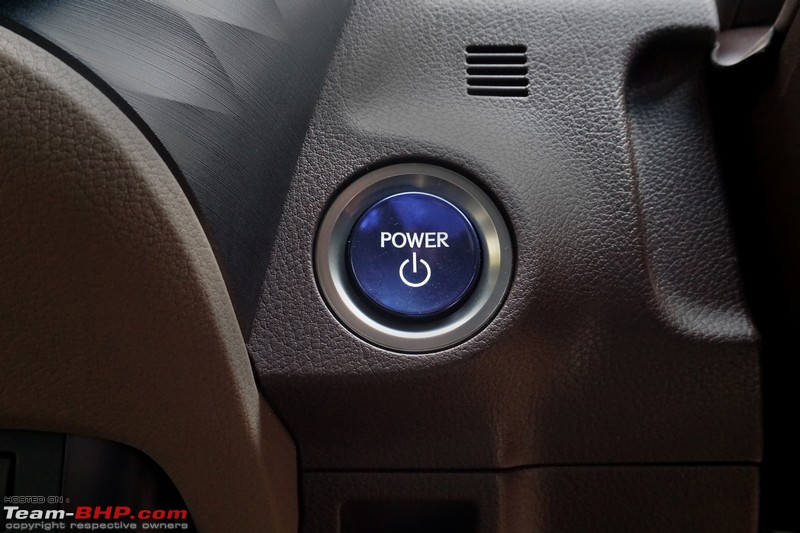
The door pad has a mix of wood and leather upholstery. The bottom part of the door is made of hard plastics. The doors are easy to open and close and they shut with a weighted thunk. The front door gets 2 speakers. Door pockets are a little small. Regular 1 litre bottles do not fit easily. Depending on the upholstery colour, the seats are matched with the door trim and door inserts. Tan interiors get more leather facing on the door compared to white or beige interiors:
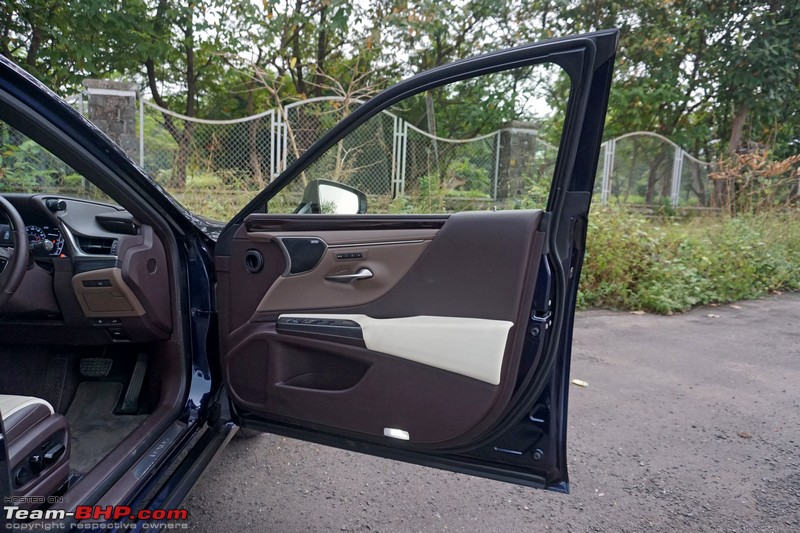
Plain and simple-looking switches for operating the power windows, adjusting the ORVMs and for central locking. Not expected of a car from this segment. The switches aren't even illuminated or finished in metal (like the Europeans). They look as if they are from a Corolla:

These horizontal ambient light strips light up at night on the dashboard and all four doors. The car also gets footwell lighting:

The seats are available in four different colour themes. When you turn off the car, the seat retracts and the steering lifts up to allow more space for easy ingress and egress. When the car is switched on, they move back to the original position. This can be disabled as part of the convenience function. Both front seats are heated and ventilated. The ventilated seats are a bit noisy when the fan is switched on. The seats are very comfortable but are a little on the narrow side. Head restraints are manually adjustable:
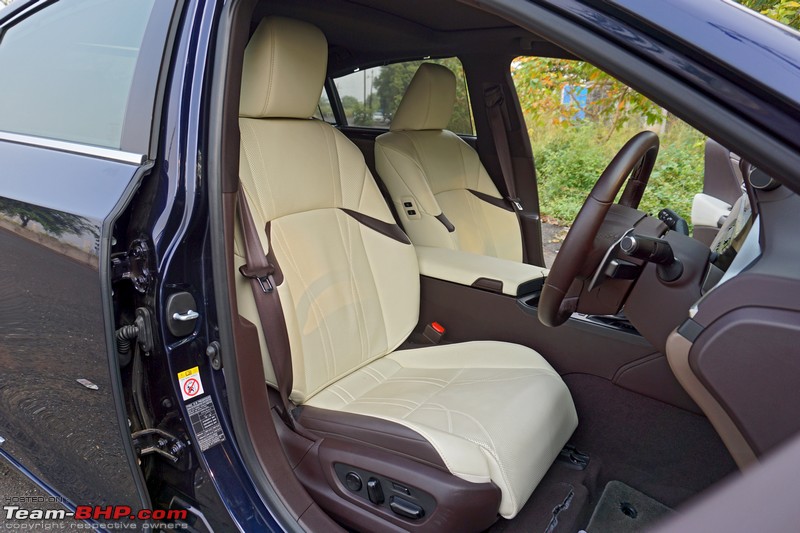
The driver's seat is 14-way electrically adjustable, while the front passenger seat is 12-way power adjustable:

The driver's seat gets an extended seat base which unfolds upwards for better under-thigh support for taller drivers:

A close up of the perforated leather seat upholstery. Light coloured seats are not the best choice for Indian conditions:
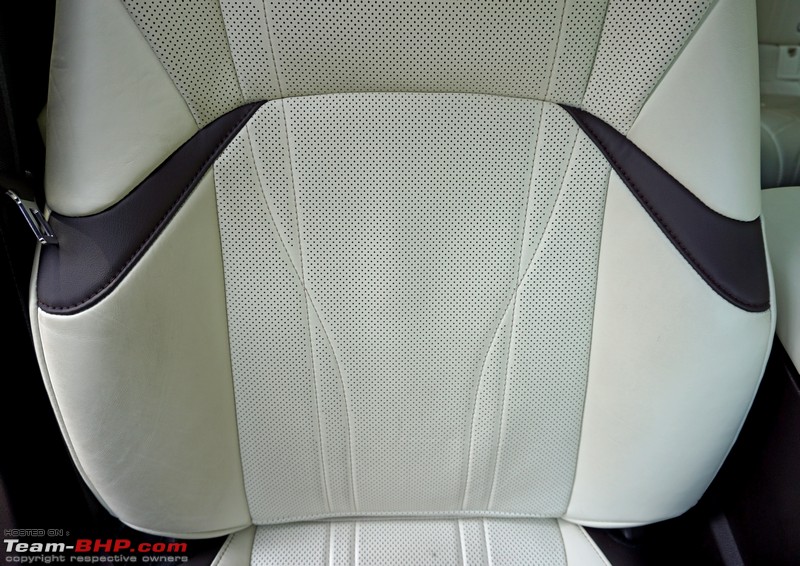
The centre console is cluttered with too many buttons. The well-integrated 12.3-inch infotainment screen is not a touchscreen. Instead, it is controlled by a touchpad next to the gear lever. The touchpad itself is placed on the wrong side of the centre console (left of the gear lever), but gets a cushion to rest your wrist on when using it. The centre console also houses buttons for the EV mode and hill hold function placed behind the gear selector:
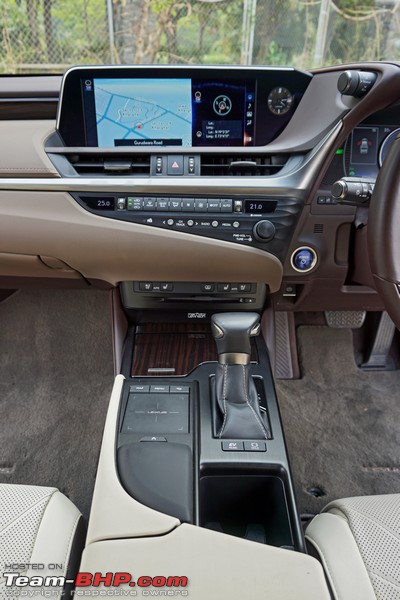
The infotainment system gives a variety of information including trip information, which also shows the amount of battery power regenerated. Maintenance schedules along with dealer location can also be set. The system supports split function which enables you to have two different information displays. The infotainment system does not get Android Auto and Apple CarPlay. US-spec cars get Apple CarPlay. Toyota has only recently started adding
Android Auto and Apple CarPlay to its cars. The infotainment system is not very intuitive to use and may take some time to understand:

The split-screen functionality gives two different views for the navigation system. Graphics have been provided to warn the driver to stick to a particular lane or while approaching a toll booth. The blue vertical bar on the right gives the distance to the next intersection and reduces as you get closer. The navigation system sounds one beep when you are nearing a junction or a direction change. When you reach the place, it makes two beeps:

The touchpad is used to control the infotainment system. This system is a pain to use and selecting an option is not easy. It also vibrates when you go over the options and it confuses the user into thinking that they accidentally pressed it. It is also uncomfortable for right-handed drivers to use. The touchpad has shortcuts for menu, navigation and return:

There is a classy analogue clock next to the infotainment screen:

The ES comes with 3-zone climate control. There is one knob on the dash for controlling both volume and radio tuner. The inner circular knob is used to tune radio stations, while the outer knob is used for volume control:

The ES comes equipped with a 1800 watt, 12-channel, 17-speaker Mark Levinson sound system with a DVD player. Controls for the heated and ventilated seats along with the electrically operated rear-sunshade are placed above the DVD slot. Lexus climate concierge uses seat heaters and ventilated seats to warm up or cool passengers before the climate control reaches optimum temperature. The AC is very effective and cools the cabin quickly. Rear sunblinds retract when reversing or by pressing this button:
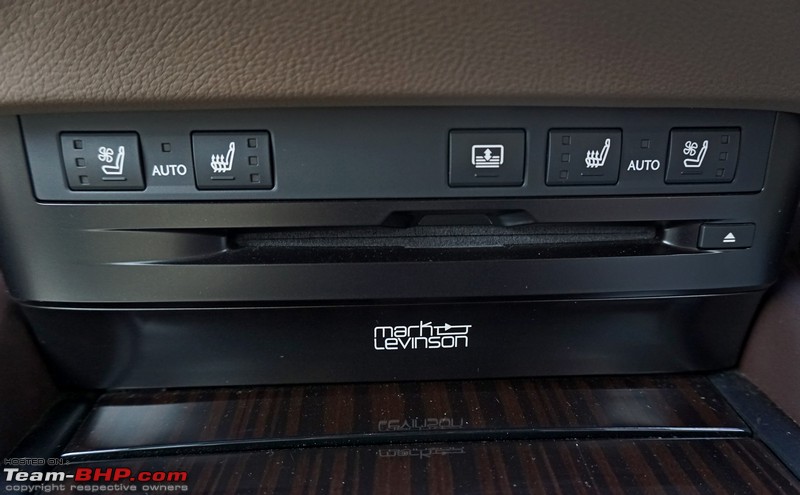
Only 1 cup holder up front. There's a USB and an AUX port next to it. The USB port lid is flimsy and feels like it can come off easily. A slot to hold the key is also present:

The centre console also has a cooled glovebox with a 12V socket and wireless charging. It is hinged on both sides and can be accessed by the driver and the passenger:

Touch operated cabin lights. Just touch anywhere on the lights to turn them on or off. The roof bezel also houses sunroof controls:

The sunroof has a manually operated blind! At this price point, not having an electrically operated blind is inexplicable:
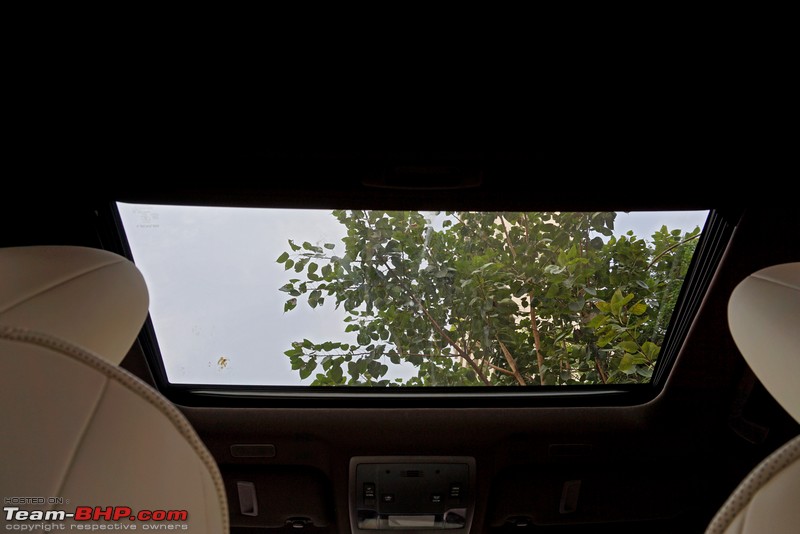
Rear doors are similar to the front doors. Rear windows and quarter glass get manually operated sunshades:
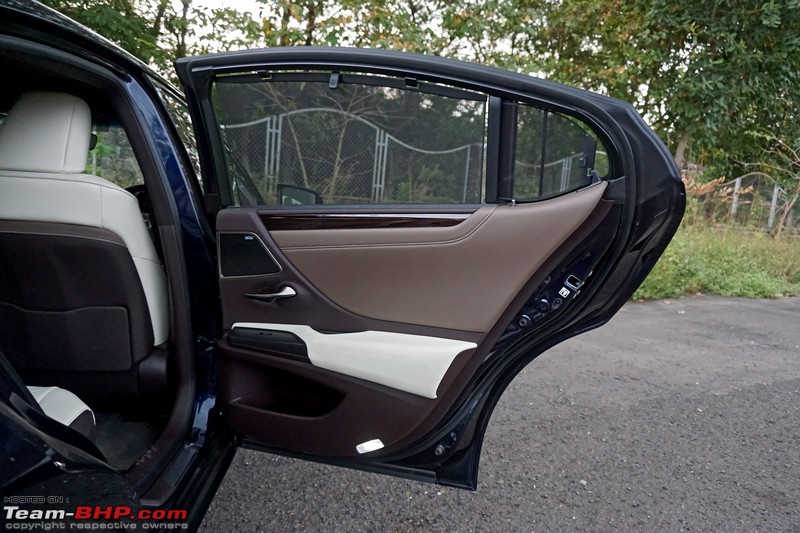
The rear seats are comfortable for only 2 occupants. The central hump makes it uncomfortable for middle seat passengers. The seats are comfortable and supportive but could do with some additional under-thigh support. They are also heated and can be reclined. The reclining seats have a very limited range. They can recline up to 8 degrees only:

Lots of legroom and headroom available. The chauffeur-driven will love it. Even 6 footers will be comfortable at the back. Picture shows excess legroom as BHPian
ChiragM is 5'4":

The rear armrest comes with 2 cupholders and controls for seat reclining, seat heating, rear climate control, audio and the rear windscreen sunshade:
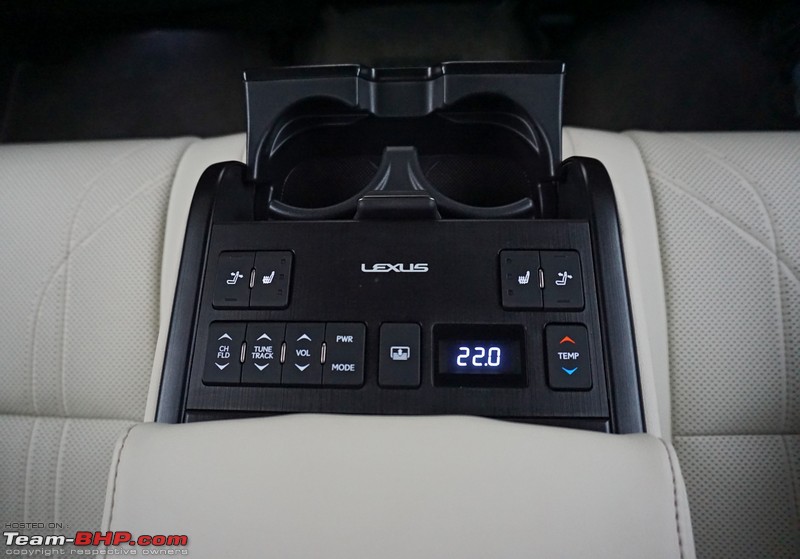
Air-con blower for the rear passengers. A 12V socket and 2 USB ports are provided below it:

Rear passengers can also control the front passenger seat using these controls on the side of the seat back (seen on Camry as well):

The rear cabin lights are not touch operated:

Vents below the rear seats to cool the batteries for the hybrid system, which are located below the rear seat. The earlier ES, as well as the Camry, had the batteries in the boot:
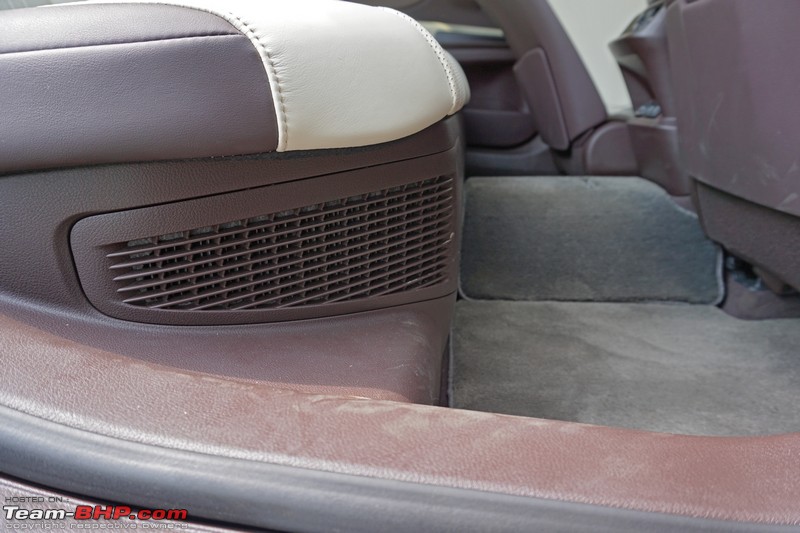
The tailgate is electrically operated. It can be opened by using the boot release button inside the car or by pressing the boot release button on the key fob. It can also be opened by using the electromagnetic boot release on the tailgate if you have the key on you. The boot can accommodate up to 454L of luggage. Useful bag hooks have been provided:
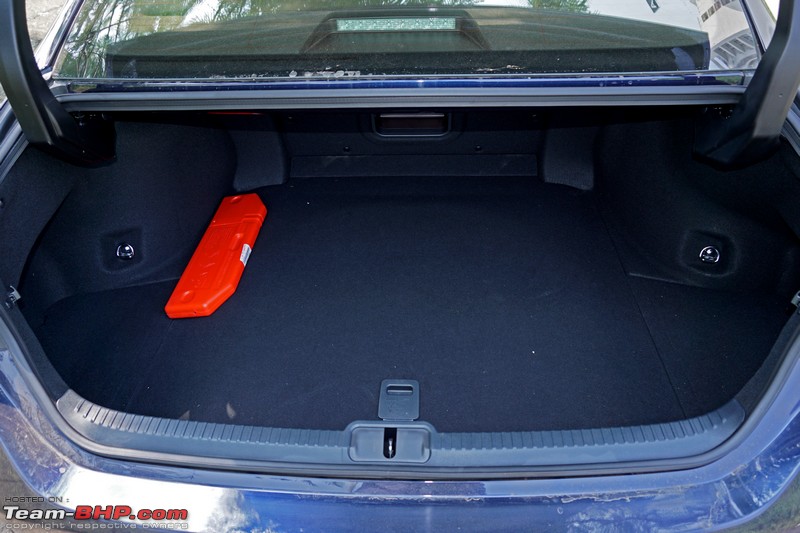
Lexus has provided a full-size spare alloy wheel:

Boot has a compartment on the side to store small articles out of sight:

The boot can be accessed from the rear sets. Good to carry long items:

Alternately, the tailgate can be opened or closed by waving your leg underneath the rear bumper. The sensor is located under the right side of the car. Here's a demonstration of how the handsfree boot works. The boot can be stopped midway while opening by waving your leg underneath:
https://www.youtube.com/watch?v=A16d...ature=youtu.be
Driving the 2.5L Hybrid
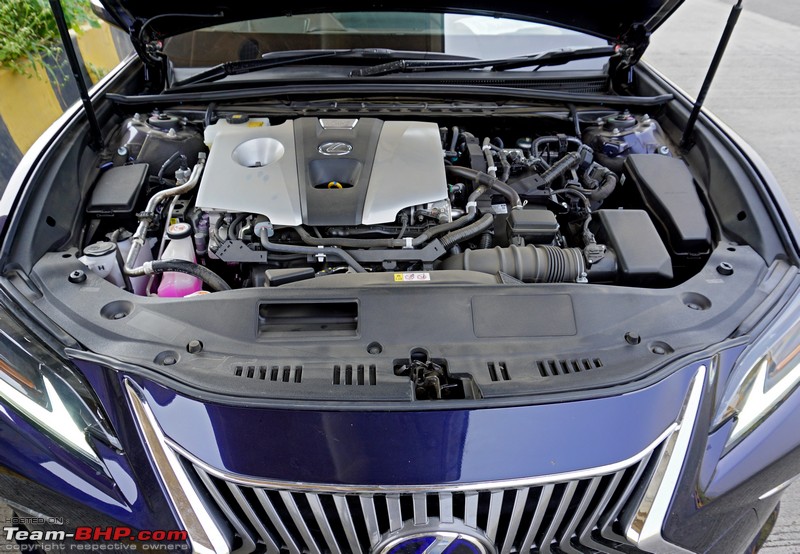
The ES 300h is not a car that will tug at your heartstrings, but will appeal to the mind as a sensible buy. Don't expect the driving thrills of a European sedan from the Lexus. What it will do is transport its passengers in serene comfort and luxury as well as efficiency.
Push the start button, and the ES comes to life with fancy visuals across the speedometer and central display. However, there is an eerie silence since the hybrid powertrain starts up in electric mode. Even after driving a couple of hybrids, the silence takes getting used to as the ES glides forward with pin drop silence. In electric mode, you actually feel cocooned from the outside world with the refinement and insulation.
The hybrid electric system is perfectly integrated as with most other Lexus / Toyota vehicles, and unless in stop and go traffic, you will seldom notice when the internal combustion engine has kicked in and gone back off. I'm sure most will be aware as to how and when it switches between electric, and electric + IC engine, so I will not go into detail in that. You can also read more about it in our Camry Hybrid
review, which has a similar hybrid powertrain.
The Lexus disappoints when it comes to driving enthusiastically. It does have a flat torque curve, which feels neverending. That is partly due to the electric motor, and partly due to the CVT transmission. The engine revvs stay at a high rpm constantly and it just feels like one long gear. Not that I was expecting anything else. I did have the chance to push it a bit on an expressway, and in the city, and while it is not a sporty car by any means, you can get it to move if you try to. It did feel a lot more fun in the city than on the highway. That said, the ES is definitely an improvement over the NX 300h.
The ES 300h feels best driven in a relaxed manner. Its happy in city traffic, and even on the open road. The suspension works silently and is very pliant. Most bumps, besides the larger ones, are absorbed well without transmitting any thuds, and it doesn't feel as though you are hurting the ES when you drive on the usual bad city roads, in spite of the relatively low profile tyres. Whether in the front seat or in the back seat, the ride quality is good. It is better than the German sedans with standard suspension, but not quite as refined as the ones with air suspension. It's not stiffly set up, so there is not a lot of lateral movement even when you are going through a rough patch. At highway speeds too, the ES feels stable as long as you don't try any enthusiastic maneuvers. Quick lane changes will make you feel the softly sprung suspension, with its body roll.
In terms of handling, it is no European. It is stable, but you can feel the body roll when you turn into a corner fast. If you take an expressway turn even at a slightly higher speed than you should, the Lexus holds its line. That being said, pushing the ES isn't exactly fun. Steering is accurate and stiffens up in Sport mode, but it lacks feel. I did find the steering to be slightly on the heavier side even in Eco mode.
Braking is strong, and the feel is good and predictable most of the times. It does give you confidence even when slowing down quickly from higher speeds. Where it does feel a bit strange, and spongy, is when the ES is in electric mode. In stop and go traffic, as with other hybrid cars with regenerative braking, it would get a tad jerky with the brakes, which is possibly the only thing I did not like about driving the car in traffic.
I was stuck in Mumbai peak hour bumper to bumper suburban traffic, which is as bad as it gets. And normally, in a BMW, I would be getting irritated, waiting for the open road to give it the beans. In the ES, I was literally chilling in the driver's seat, ventilation on, car in electric mode, not bothered about the traffic around me, and not even in a rush to get where I wanted to be.
In terms of kitna deti hai aka the fuel efficiency. On my normal 25 km commute, I reset the trip meter. And in say, the 320d, the onboard FE display would show me maybe 11 kmpl. The Lexus display was showing 14. So I would say it is very efficient for moving traffic.
To sum it up, the Lexus ES 300h is a good buy for someone looking for a comfortable, refined and efficient vehicle.
New hybrid badging on the engine cover. The engine powers the wheels as well as charge the batteries:
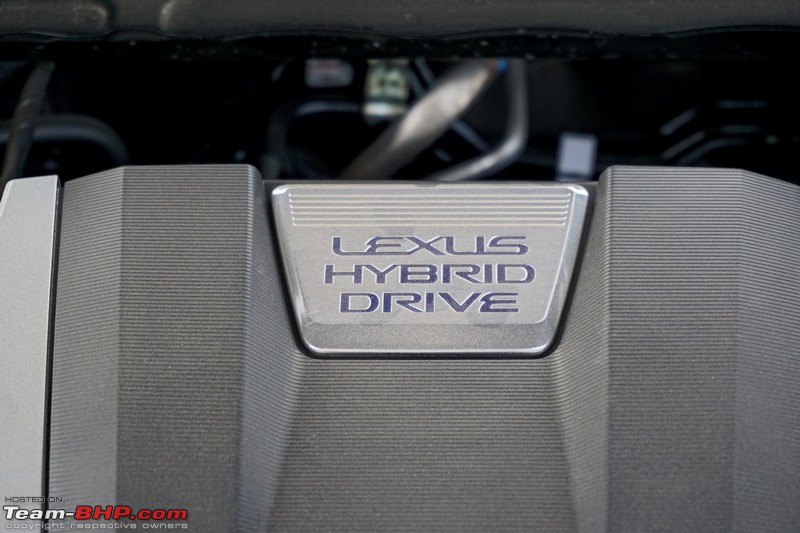
The power control unit has been placed next to the engine. It consists of an inverter, boost converter and a DC/DC converter:

In the event of a front collision with a pedestrian, the hood pops up for additional pedestrian protection:

The car comes with three different driving modes: Eco, Normal and Sport. In Sport, the instrument cluster turns red. It remains blue in Normal, and in Eco, it gets more blue lighting:

An Eco sign pops up on the infotainment screen when the car is switched to Eco mode:

The new ES 300h comes with Auto Glide Control (AGC). When you lift off the throttle, the car starts decelerating, in a manner similar to coasting in neutral:
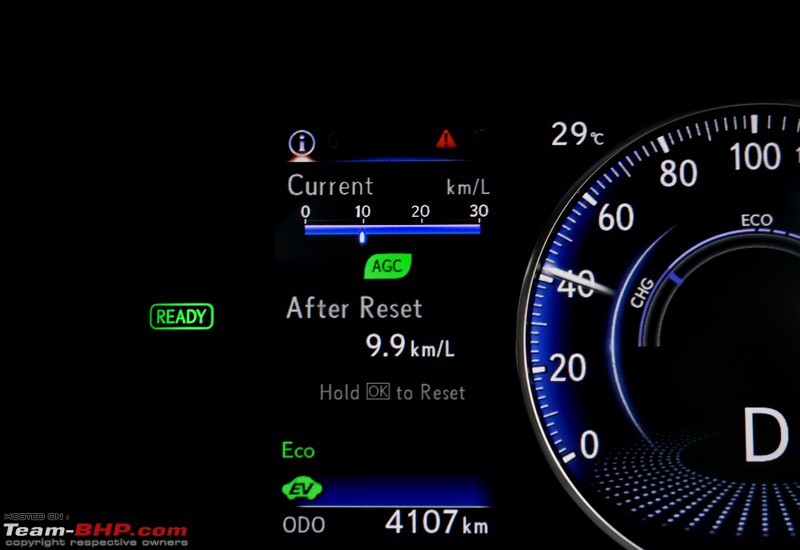
The different graphics when the car is running in electric mode only, when the electric motor and the engine work together to power the car, and during regeneration:

Other Points
• Lexus currently has dealers in Delhi, Gurgaon, Mumbai and Bangalore. Service centres are at Delhi, Gurgaon, Mumbai, Bangalore, Hyderabad, Chandigarh, Chennai and Kochi.
• While there are 8 service corners - dedicated service bays for Lexus in a few existing Toyota workshops, a salesperson at Lexus told us that servicing your Lexus in other cities will be just as easy. The company will fly down technicians to the car who take it to the nearest Toyota workshop for the needful. Lexus has a reputation for pampering its customers.
• Lexus offers a 1,00,000 km / 3 year warranty as standard. An additional 50,000 km / 2 year warranty can be taken for the hybrid battery.
Sensors for the handsfree boot release are placed under the rear bumper:

The side windows, including the rear quarter glass, get UV-cut glass to protect the occupants from UV rays:

Lexus has provided an insulation sheet under the bonnet:

The Lexus ES parked behind its bigger sibling, the Lexus LS:

The sedan received a 5-star safety rating from Euro NCAP:
https://www.youtube.com/watch?time_c...&v=6ottgh2XFZ8
For the launch of the ES in Europe, Lexus created the world's first
ad scripted by artificial intelligence:
https://www.youtube.com/watch?v=BhKw71AeOg4 Disclaimer: Lexus invited Team-BHP for the ES 300h test-drive. They covered all the travel expenses for this driving event.
Thread moved from the Assembly Line to the Test-Drives Section. Thanks for sharing!
Great review and a very practical car for Bombay traffic. The only hitch remains the pricing - a car that undercuts the 5 or E is being sold at a premium. But the premium seems less than before.
Presume Lexus will never consider locally assembling this on the same line as the Camry. We have to hope that Trump arm twists India into reducing CBU duties if we want this at a reasonable price.
Excellent review folks. Thanks for those detailed photos. This is a car you buy if you are comfortable paying a premium for the top class service and courtesy at every step. Lexus are not likely to assemble in India anytime in the forseeable future and we'll have to live with the pricing.
As much as I admire Lexus as a brand the only thing that I see poking a hole in TKM's plans for this marque in India is the price and next the service network. I am sure they'll fix the service network part. But not the price at least in the mid term. And that is a big problem as I see it for now.
My family's first Toyota was a
Corona Mark II that my Dad purchased in 1971-72 whilst we were posted overseas. I was a little boy back then. So over the past nearly 5 decades I have been kind of used to seeing Toyota dishing out bland, uninspiring and dare I controversial designs. The snarling alien
Predator face grille and its numerous derivatives becoming ever so common on their late model designs is definitely one of the controversial ones. It doesn't really float my boat but then it may taking a bit of getting used to.
But if someone wants a nice looking reliable hybrid car, with reasonable maintenance costs by a company that really, really knows how to look after and even pamper their customers decades after purchase this is the one for you. It ain't exciting to drive like a Euro sedan but is comfortable and boringly reliable like most Jap machines. Besides the Saheb ain't gonna drive anyways and fun-to-drive or not should make little difference to him. Hey, but this car does tick enough boxes to make a burra Saheb smile.
In addition to my viewpoints, this is the second car that I have fallen asleep in the back during a high speed run. The other was the new E Class. For a gridlocked city like Bangalore, this is ideal, easy to manage, great stereo, and hybrid drivetrain.
On the Mathura Highway, it does transmit the roar of the concrete but the sensation was more like riding in a TGV train, very linear high speed acceleration.
The exterior finish is amazing but I was disappointed with some of the cheaper Toyota bits an pieces inside.
A good effort but the price is something else. If you are keeping this car and passing it onto your kids, pesky younger brother or spendthrift sister - this is it.
The infotainment system takes a while to get used to.
Great Review Akshay & Team :thumbs up
Really feel bad for the previous gen ES300H owners as clearly Lexus India could have skipped the previous gen (which had launched in India around May 2017) for India, As within 15 months Lexus India launched this all new ES300H (In August 2018).
Quote:
Originally Posted by karan561
(Post 4526283)
Really feel bad for the previous gen ES300H owners as clearly Lexus India could have skipped the previous gen (which had launched in India around May 2017) for India, As within 15 months Lexus India launched this all new ES300H (In August 2018).
|
Me. Me. Me! Some would say I told you so:D
Purely for the chauffer driven, there seems to be no logic in spending 30 L extra & getting this car over the Camry. In the rear, aside from heated seats, I don't see any other feature this car has over the Camry (don't know if Camry has heated rear seats or not). Back seat comfort has always been the hallmark of the Camry, trumping everything else south of 1 cr, barring E class. This leaves the Lexus in a very precarious position as a potential choice for sethji
Great review guys!
As an ES300h owner I was hoping to see few improvements:
- Ground clearance is a major issue, our ES bottoms more than my RS5. Seems they haven't resolved this.
- Panoramic roof, the sunroof is just too small and doesn't cut it for a car in this segment.
- Infotainment system felt dated, I am glad they have resolved this to some extent.
- The drivers seat is not the most comfortable mainly due to the under thigh support, good to see a good amount of electric thigh support extending in an interesting way.
However, I am glad the design is more evolutionary especially from the front, so existing ES300h owner like me don't feel too bad :p
Quote:
Originally Posted by V.Narayan
(Post 4526311)
Me. Me. Me! Some would say I told you so:D
|
HaHa lol:
Narayan Saab, this post was directed towards Lexus India so they can compensate you by a fair trade in offer for your car for this all new ES300H at a nominal cost :D
| All times are GMT +5.5. The time now is 06:37. | |















































































